Conceptual Framework in Accounting: RIO TINTO and Glen Core Analysis
VerifiedAdded on 2023/03/23
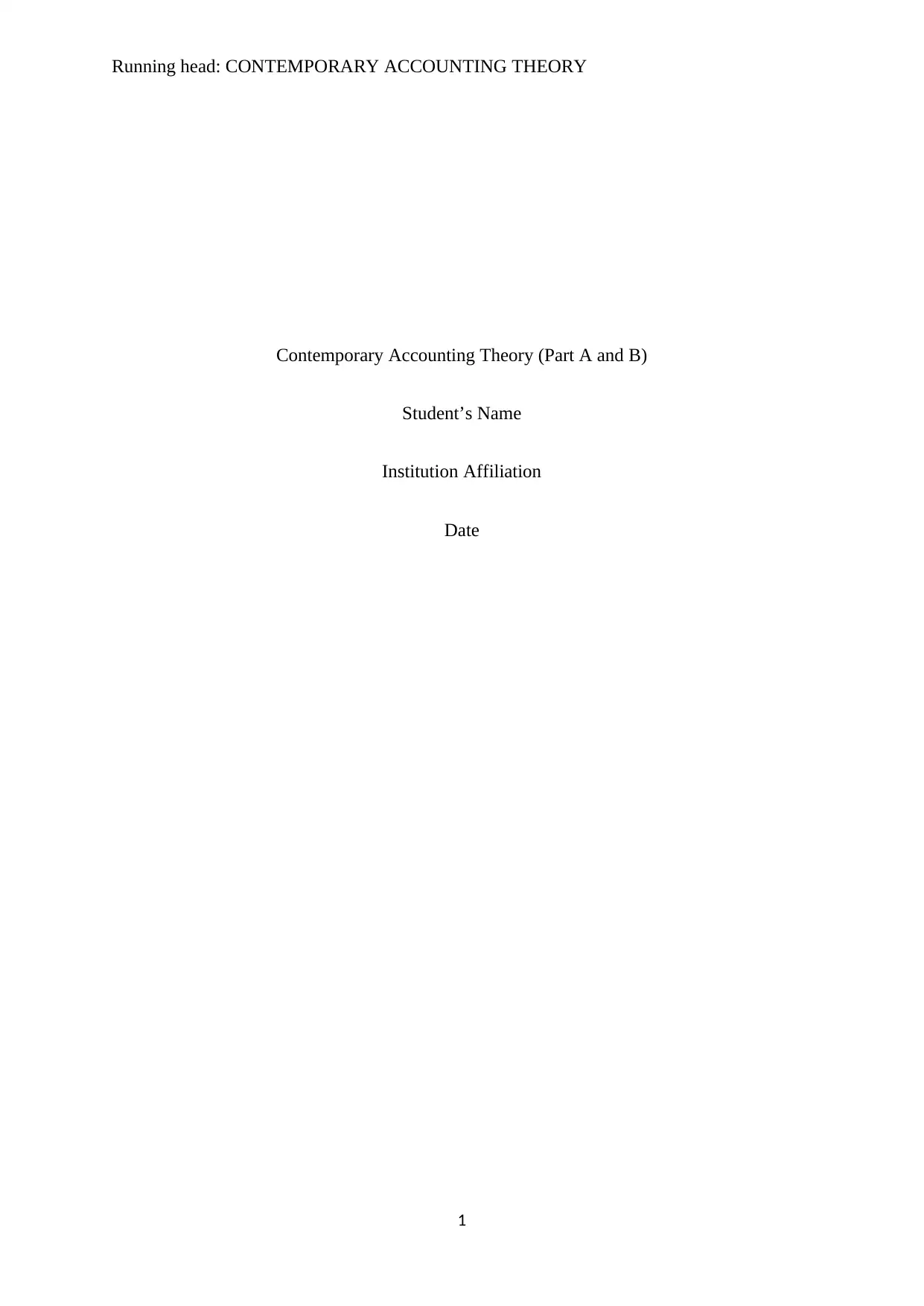
Contemporary Accounting Theory (Part A and B)
Student’s Name
Institution Affiliation
Date
1
Paraphrase This Document
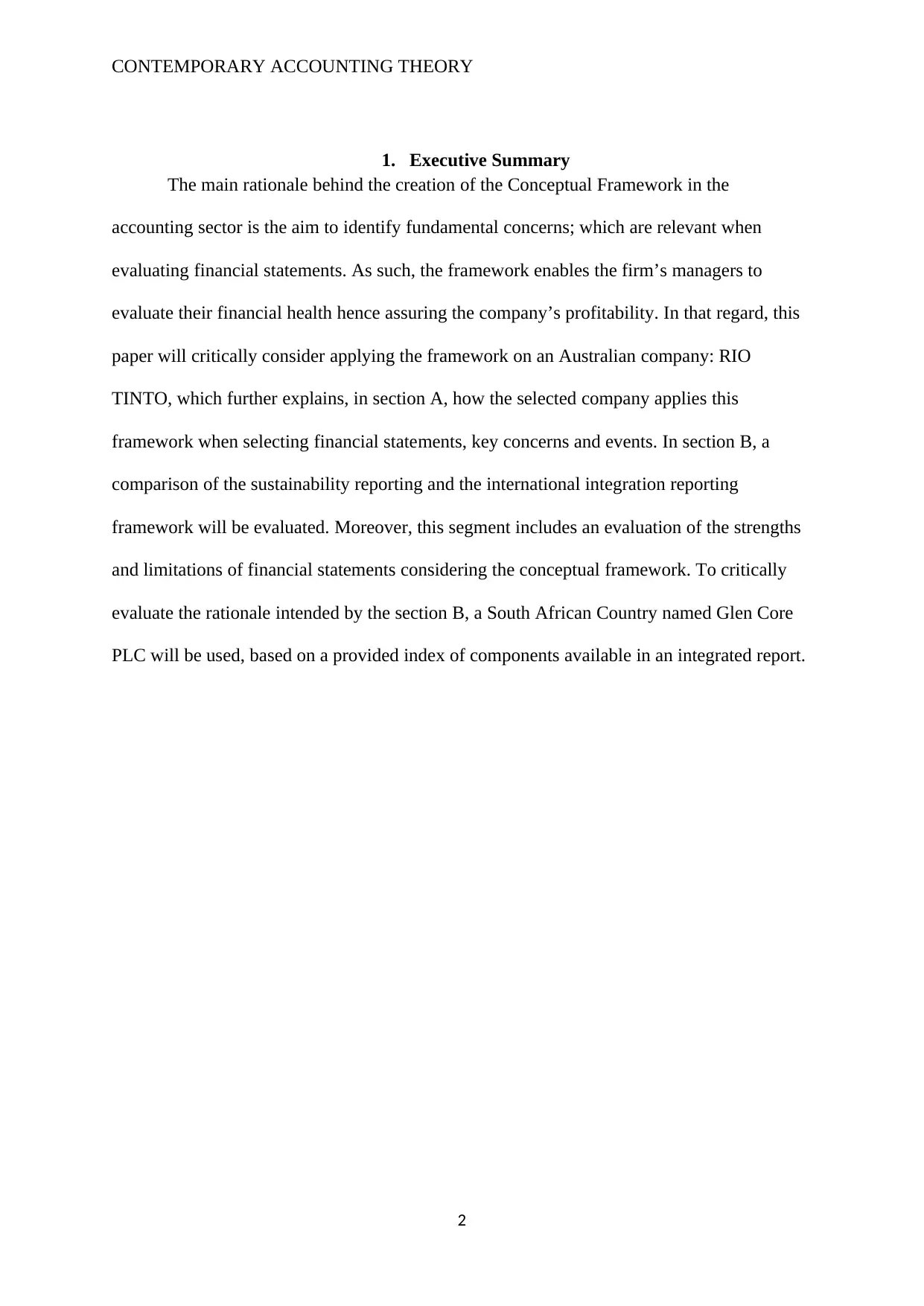
1. Executive Summary
The main rationale behind the creation of the Conceptual Framework in the
accounting sector is the aim to identify fundamental concerns; which are relevant when
evaluating financial statements. As such, the framework enables the firm’s managers to
evaluate their financial health hence assuring the company’s profitability. In that regard, this
paper will critically consider applying the framework on an Australian company: RIO
TINTO, which further explains, in section A, how the selected company applies this
framework when selecting financial statements, key concerns and events. In section B, a
comparison of the sustainability reporting and the international integration reporting
framework will be evaluated. Moreover, this segment includes an evaluation of the strengths
and limitations of financial statements considering the conceptual framework. To critically
evaluate the rationale intended by the section B, a South African Country named Glen Core
PLC will be used, based on a provided index of components available in an integrated report.
2
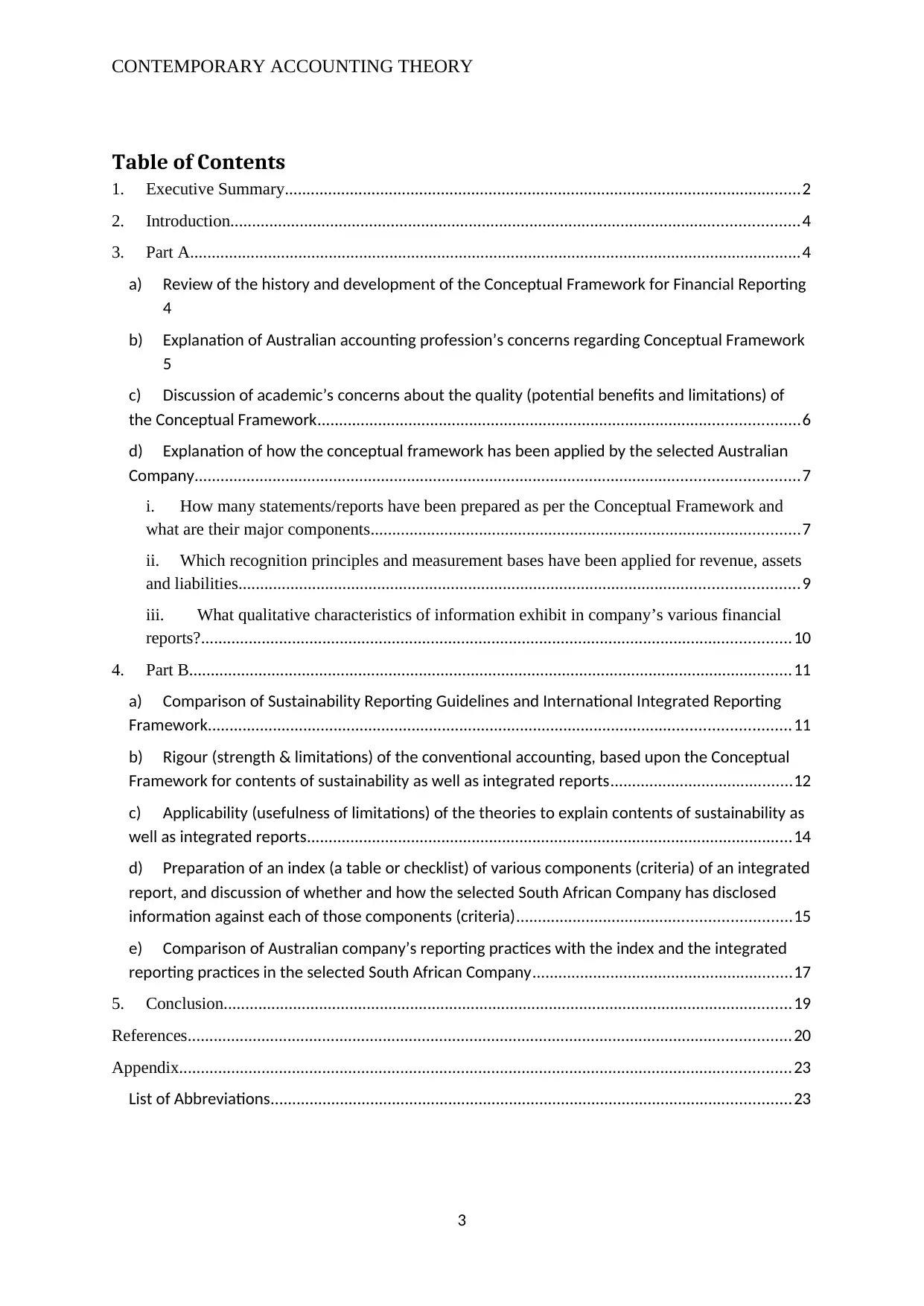
Table of Contents
1. Executive Summary.......................................................................................................................2
2. Introduction...................................................................................................................................4
3. Part A.............................................................................................................................................4
a) Review of the history and development of the Conceptual Framework for Financial Reporting
4
b) Explanation of Australian accounting profession’s concerns regarding Conceptual Framework
5
c) Discussion of academic’s concerns about the quality (potential benefits and limitations) of
the Conceptual Framework...............................................................................................................6
d) Explanation of how the conceptual framework has been applied by the selected Australian
Company...........................................................................................................................................7
i. How many statements/reports have been prepared as per the Conceptual Framework and
what are their major components...................................................................................................7
ii. Which recognition principles and measurement bases have been applied for revenue, assets
and liabilities.................................................................................................................................9
iii. What qualitative characteristics of information exhibit in company’s various financial
reports?........................................................................................................................................10
4. Part B...........................................................................................................................................11
a) Comparison of Sustainability Reporting Guidelines and International Integrated Reporting
Framework......................................................................................................................................11
b) Rigour (strength & limitations) of the conventional accounting, based upon the Conceptual
Framework for contents of sustainability as well as integrated reports..........................................12
c) Applicability (usefulness of limitations) of the theories to explain contents of sustainability as
well as integrated reports................................................................................................................14
d) Preparation of an index (a table or checklist) of various components (criteria) of an integrated
report, and discussion of whether and how the selected South African Company has disclosed
information against each of those components (criteria)...............................................................15
e) Comparison of Australian company’s reporting practices with the index and the integrated
reporting practices in the selected South African Company............................................................17
5. Conclusion...................................................................................................................................19
References...........................................................................................................................................20
Appendix.............................................................................................................................................23
List of Abbreviations........................................................................................................................23
3
⊘ This is a preview!⊘
Do you want full access?
Subscribe today to unlock all pages.

Trusted by 1+ million students worldwide
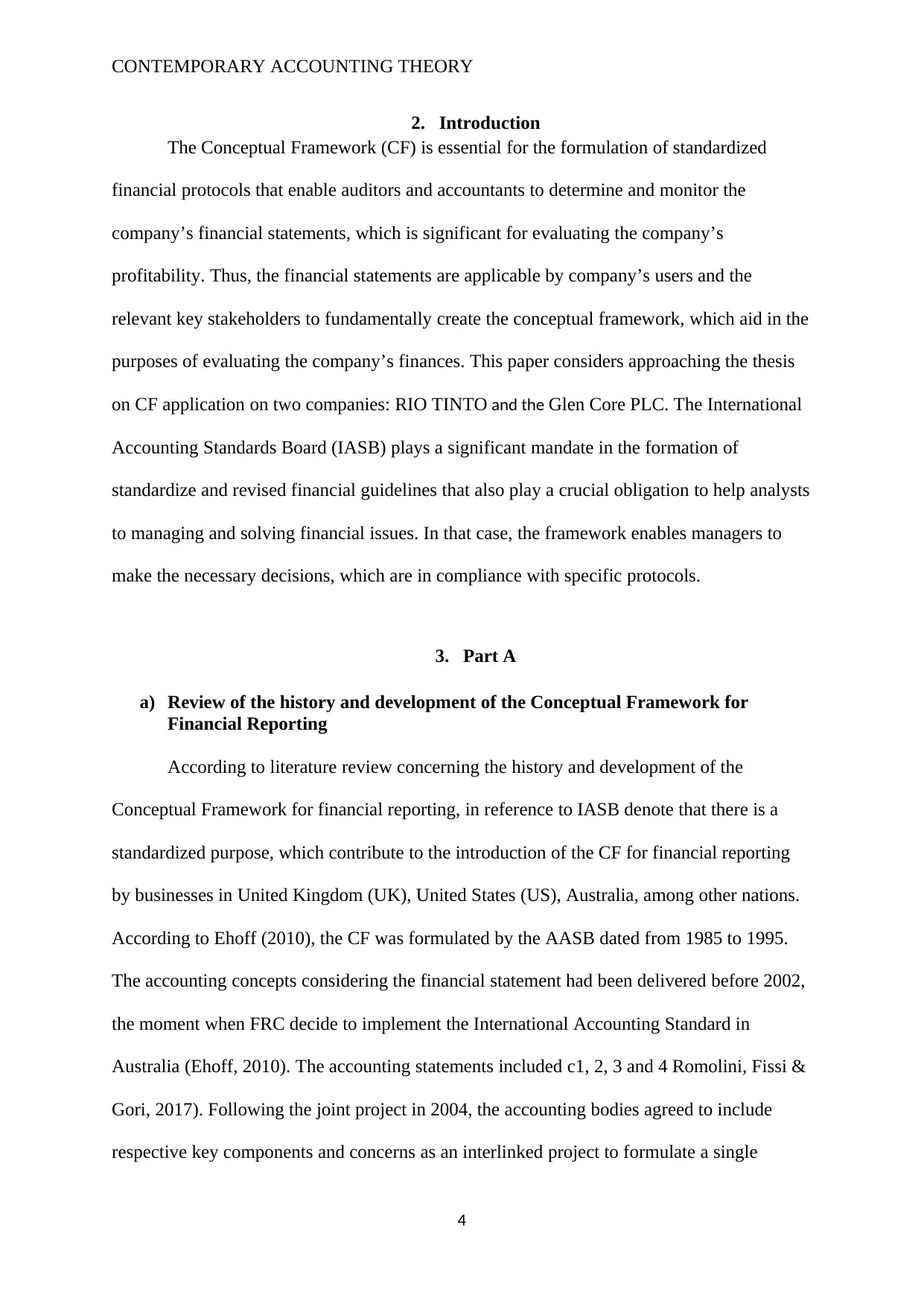
2. Introduction
The Conceptual Framework (CF) is essential for the formulation of standardized
financial protocols that enable auditors and accountants to determine and monitor the
company’s financial statements, which is significant for evaluating the company’s
profitability. Thus, the financial statements are applicable by company’s users and the
relevant key stakeholders to fundamentally create the conceptual framework, which aid in the
purposes of evaluating the company’s finances. This paper considers approaching the thesis
on CF application on two companies: RIO TINTO and the Glen Core PLC. The International
Accounting Standards Board (IASB) plays a significant mandate in the formation of
standardize and revised financial guidelines that also play a crucial obligation to help analysts
to managing and solving financial issues. In that case, the framework enables managers to
make the necessary decisions, which are in compliance with specific protocols.
3. Part A
a) Review of the history and development of the Conceptual Framework for
Financial Reporting
According to literature review concerning the history and development of the
Conceptual Framework for financial reporting, in reference to IASB denote that there is a
standardized purpose, which contribute to the introduction of the CF for financial reporting
by businesses in United Kingdom (UK), United States (US), Australia, among other nations.
According to Ehoff (2010), the CF was formulated by the AASB dated from 1985 to 1995.
The accounting concepts considering the financial statement had been delivered before 2002,
the moment when FRC decide to implement the International Accounting Standard in
Australia (Ehoff, 2010). The accounting statements included c1, 2, 3 and 4 Romolini, Fissi &
Gori, 2017). Following the joint project in 2004, the accounting bodies agreed to include
respective key components and concerns as an interlinked project to formulate a single
4
Paraphrase This Document
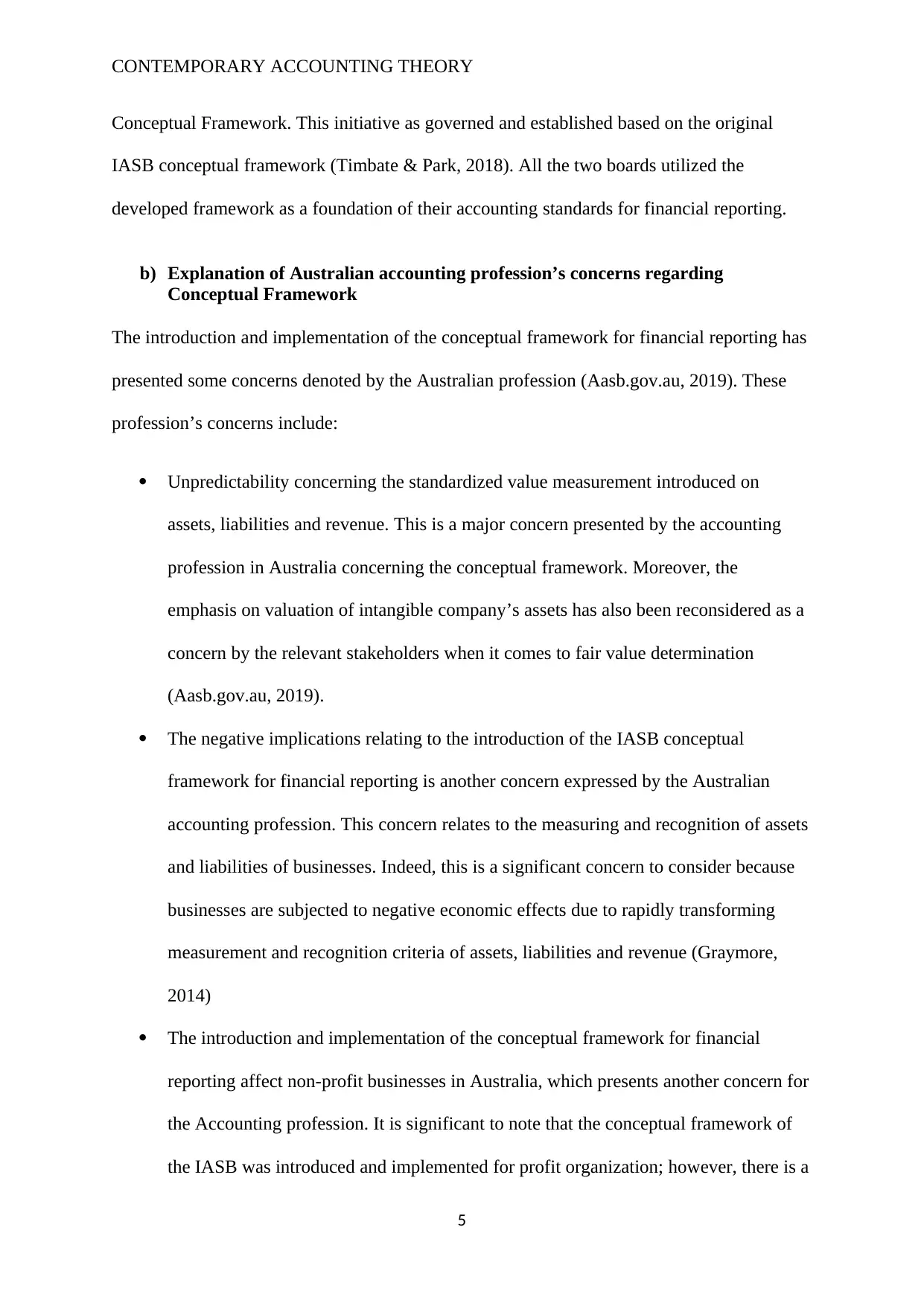
Conceptual Framework. This initiative as governed and established based on the original
IASB conceptual framework (Timbate & Park, 2018). All the two boards utilized the
developed framework as a foundation of their accounting standards for financial reporting.
b) Explanation of Australian accounting profession’s concerns regarding
Conceptual Framework
The introduction and implementation of the conceptual framework for financial reporting has
presented some concerns denoted by the Australian profession (Aasb.gov.au, 2019). These
profession’s concerns include:
Unpredictability concerning the standardized value measurement introduced on
assets, liabilities and revenue. This is a major concern presented by the accounting
profession in Australia concerning the conceptual framework. Moreover, the
emphasis on valuation of intangible company’s assets has also been reconsidered as a
concern by the relevant stakeholders when it comes to fair value determination
(Aasb.gov.au, 2019).
The negative implications relating to the introduction of the IASB conceptual
framework for financial reporting is another concern expressed by the Australian
accounting profession. This concern relates to the measuring and recognition of assets
and liabilities of businesses. Indeed, this is a significant concern to consider because
businesses are subjected to negative economic effects due to rapidly transforming
measurement and recognition criteria of assets, liabilities and revenue (Graymore,
2014)
The introduction and implementation of the conceptual framework for financial
reporting affect non-profit businesses in Australia, which presents another concern for
the Accounting profession. It is significant to note that the conceptual framework of
the IASB was introduced and implemented for profit organization; however, there is a
5
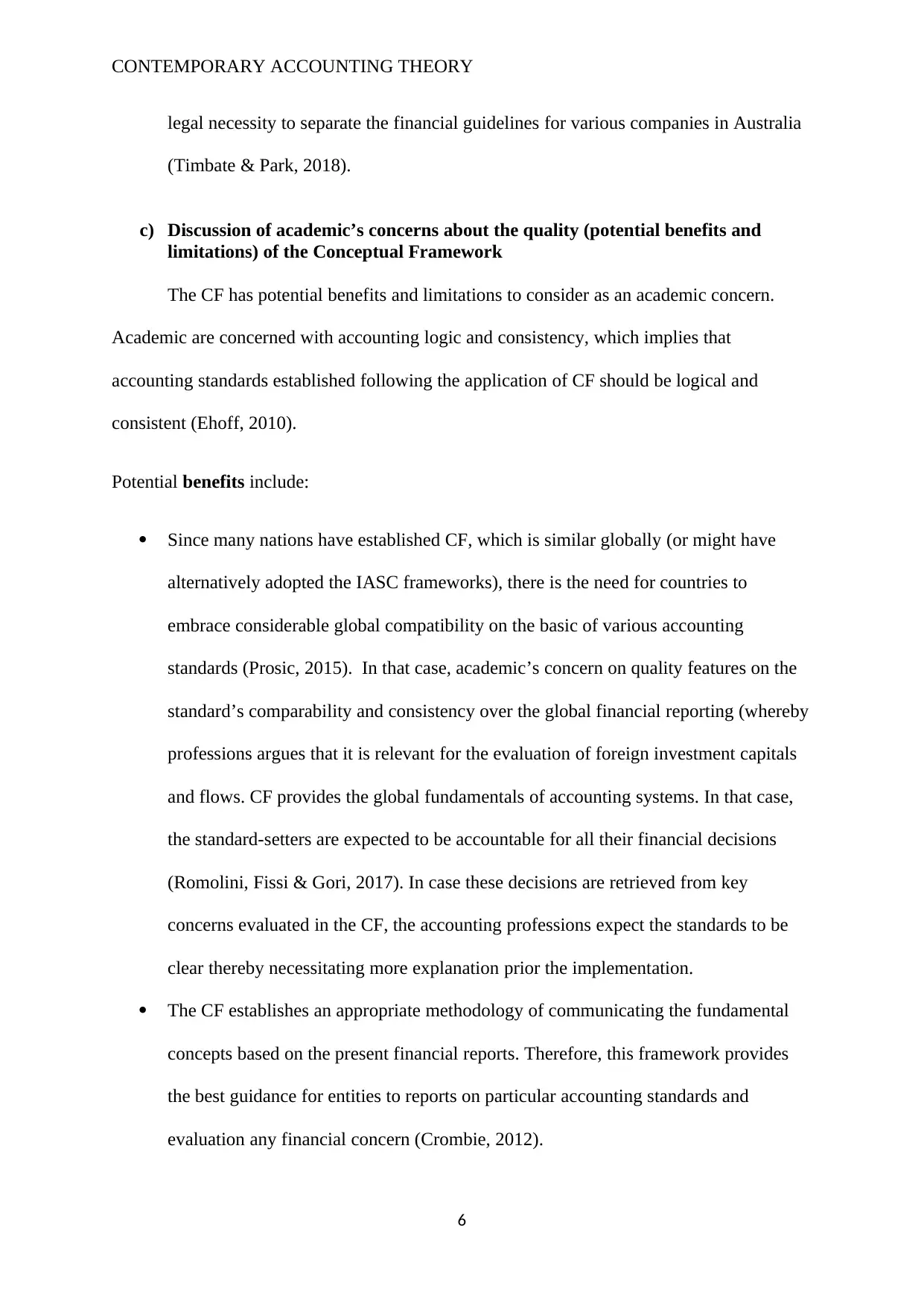
legal necessity to separate the financial guidelines for various companies in Australia
(Timbate & Park, 2018).
c) Discussion of academic’s concerns about the quality (potential benefits and
limitations) of the Conceptual Framework
The CF has potential benefits and limitations to consider as an academic concern.
Academic are concerned with accounting logic and consistency, which implies that
accounting standards established following the application of CF should be logical and
consistent (Ehoff, 2010).
Potential benefits include:
Since many nations have established CF, which is similar globally (or might have
alternatively adopted the IASC frameworks), there is the need for countries to
embrace considerable global compatibility on the basic of various accounting
standards (Prosic, 2015). In that case, academic’s concern on quality features on the
standard’s comparability and consistency over the global financial reporting (whereby
professions argues that it is relevant for the evaluation of foreign investment capitals
and flows. CF provides the global fundamentals of accounting systems. In that case,
the standard-setters are expected to be accountable for all their financial decisions
(Romolini, Fissi & Gori, 2017). In case these decisions are retrieved from key
concerns evaluated in the CF, the accounting professions expect the standards to be
clear thereby necessitating more explanation prior the implementation.
The CF establishes an appropriate methodology of communicating the fundamental
concepts based on the present financial reports. Therefore, this framework provides
the best guidance for entities to reports on particular accounting standards and
evaluation any financial concern (Crombie, 2012).
6
⊘ This is a preview!⊘
Do you want full access?
Subscribe today to unlock all pages.

Trusted by 1+ million students worldwide

Accounting-setters will experience minimal political pressure during the formulation
of more accounting standards since the relevant concerns like the objectives of
financial reports, criterion to recognition have been considered following the
establishment of the CF.
A portion of the limitations that have been related to conceptual frameworks of bookkeeping
include:
Conceptual frameworks are outrageous to formulate.
The enhancement of the CF is affected by the governmental actions. With this, some
accountants present the concern that CFs is more inclined to political procedures.
Linked to the limitation outlined above, whenever the CF considers involving
accounting concerns, there is always an issue of financial estimation of given assets as
argued by (Molyneux & Wilson, 2017).
The CFs considers more on financial-related matters. In that case, this framework will
consider disregarding various execution segments such as ecological and social revealing
components (Timbate & Park, 2018). Moreover, through the evaluation of financial
execution, CFs critically transits the consideration of financial analysts based on corporate
execution.
d) Explanation of how the conceptual framework has been applied by the selected
Australian Company
i. How many statements/reports have been prepared as per the Conceptual Framework
and what are their major components
7
Paraphrase This Document
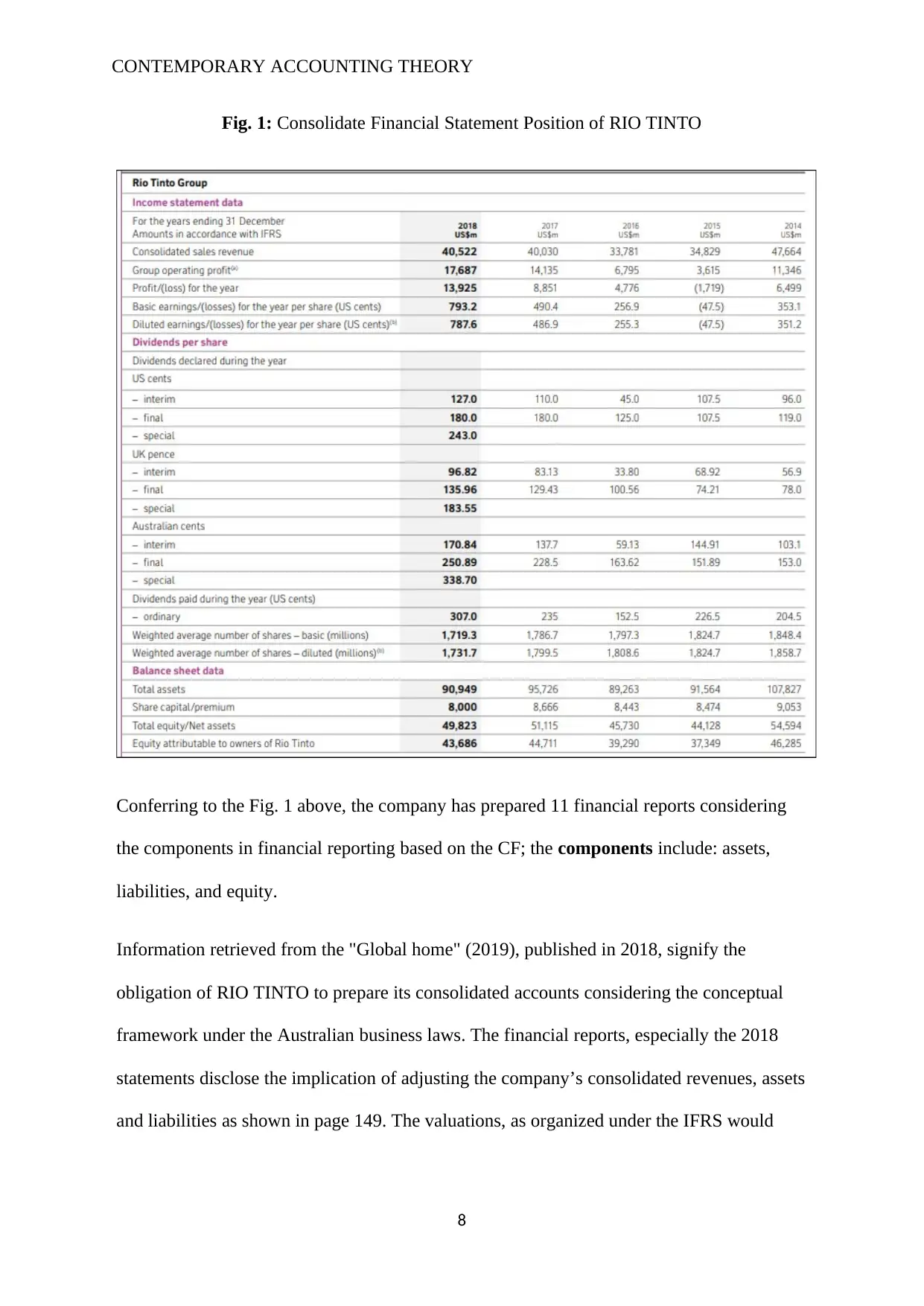
Fig. 1: Consolidate Financial Statement Position of RIO TINTO
Conferring to the Fig. 1 above, the company has prepared 11 financial reports considering
the components in financial reporting based on the CF; the components include: assets,
liabilities, and equity.
Information retrieved from the "Global home" (2019), published in 2018, signify the
obligation of RIO TINTO to prepare its consolidated accounts considering the conceptual
framework under the Australian business laws. The financial reports, especially the 2018
statements disclose the implication of adjusting the company’s consolidated revenues, assets
and liabilities as shown in page 149. The valuations, as organized under the IFRS would
8
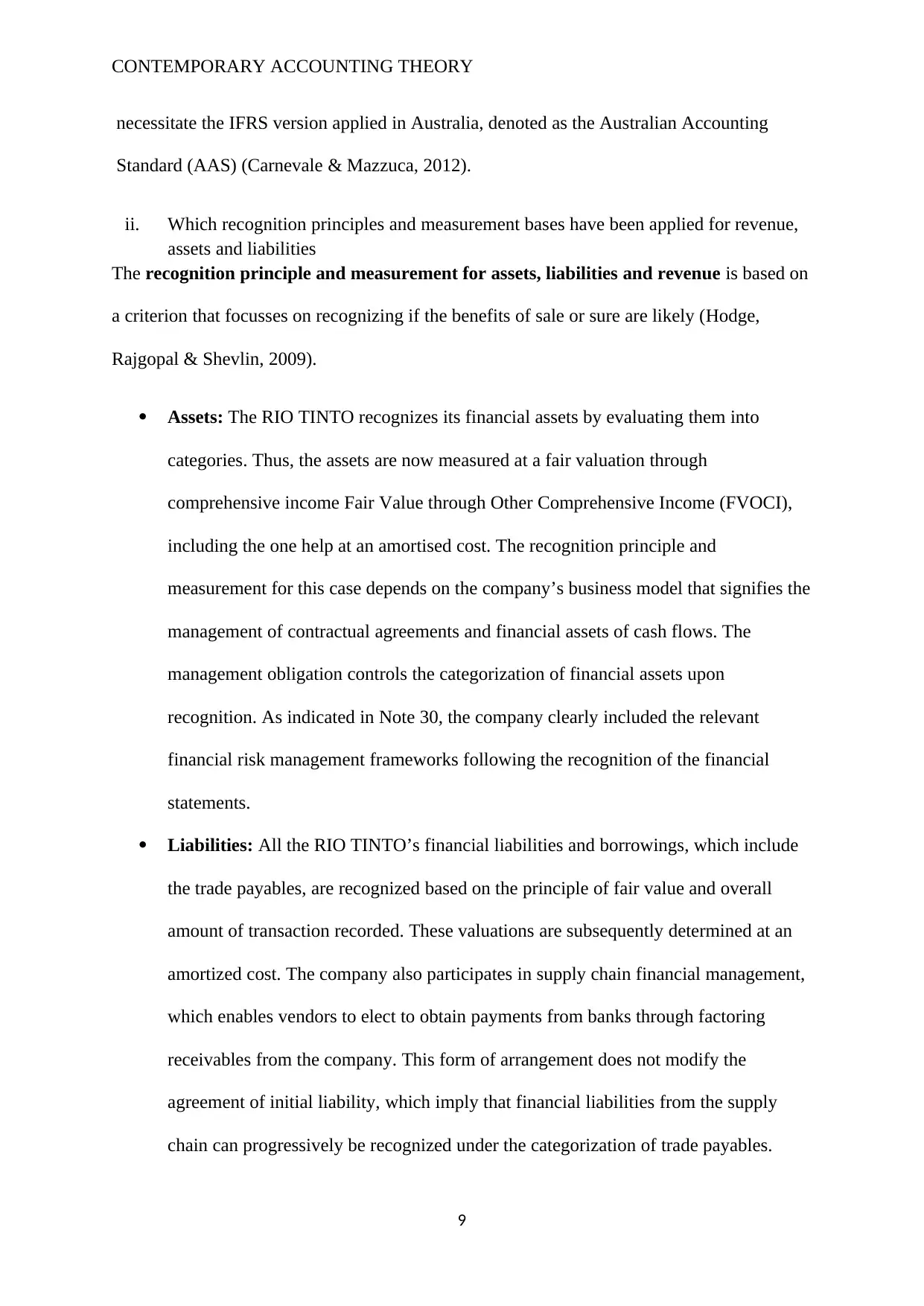
necessitate the IFRS version applied in Australia, denoted as the Australian Accounting
Standard (AAS) (Carnevale & Mazzuca, 2012).
ii. Which recognition principles and measurement bases have been applied for revenue,
assets and liabilities
The recognition principle and measurement for assets, liabilities and revenue is based on
a criterion that focusses on recognizing if the benefits of sale or sure are likely (Hodge,
Rajgopal & Shevlin, 2009).
Assets: The RIO TINTO recognizes its financial assets by evaluating them into
categories. Thus, the assets are now measured at a fair valuation through
comprehensive income Fair Value through Other Comprehensive Income (FVOCI),
including the one help at an amortised cost. The recognition principle and
measurement for this case depends on the company’s business model that signifies the
management of contractual agreements and financial assets of cash flows. The
management obligation controls the categorization of financial assets upon
recognition. As indicated in Note 30, the company clearly included the relevant
financial risk management frameworks following the recognition of the financial
statements.
Liabilities: All the RIO TINTO’s financial liabilities and borrowings, which include
the trade payables, are recognized based on the principle of fair value and overall
amount of transaction recorded. These valuations are subsequently determined at an
amortized cost. The company also participates in supply chain financial management,
which enables vendors to elect to obtain payments from banks through factoring
receivables from the company. This form of arrangement does not modify the
agreement of initial liability, which imply that financial liabilities from the supply
chain can progressively be recognized under the categorization of trade payables.
9
⊘ This is a preview!⊘
Do you want full access?
Subscribe today to unlock all pages.

Trusted by 1+ million students worldwide

Revenue: The RIO TINTO recognizes its revenue connected to the transfers of good
and services whenever the products pass to the clients. The valuation of these
revenues denoted reflect the deliberation to which the company is, including its state
it desires to entitle its exchange of products. Revenues are also recognizes under
individual sales whenever control is assigned to the clients. In most cases, the sales
revenues and control passes are recognizes when the goods and services are delivered
to client’s premises.
iii. What qualitative characteristics of information exhibit in company’s various financial
reports?
The qualitative characteristics of information exhibited in company’s various financial
reports include:
Understandability: The RIO TINTO presents its financial statements, which are
readily understandable by its users. The company also ensured to clearly present its
data, including additional information supported by past financial reports and
reference documentation, which aid in clarification.
Relevance: According to Crombie (2012), financial information must be relevant to
users especially when it significantly impact the financial decision of the company’s
users. In that case, the RIO TINTO ensures to report on particular relevant financial
data, or information whose misstatement and omission might have a significant
impact on economic planning of users.
Reliability: Financial information has to be free from bias and material errors. In that
case, the company ensures that the data released is not misleading and faithfully
presented of its financial statements and transactions. The valuation of statements for
this case ensures that information consider underlying events, uncertainties and
estimates in appropriate disclosure.
10
Paraphrase This Document
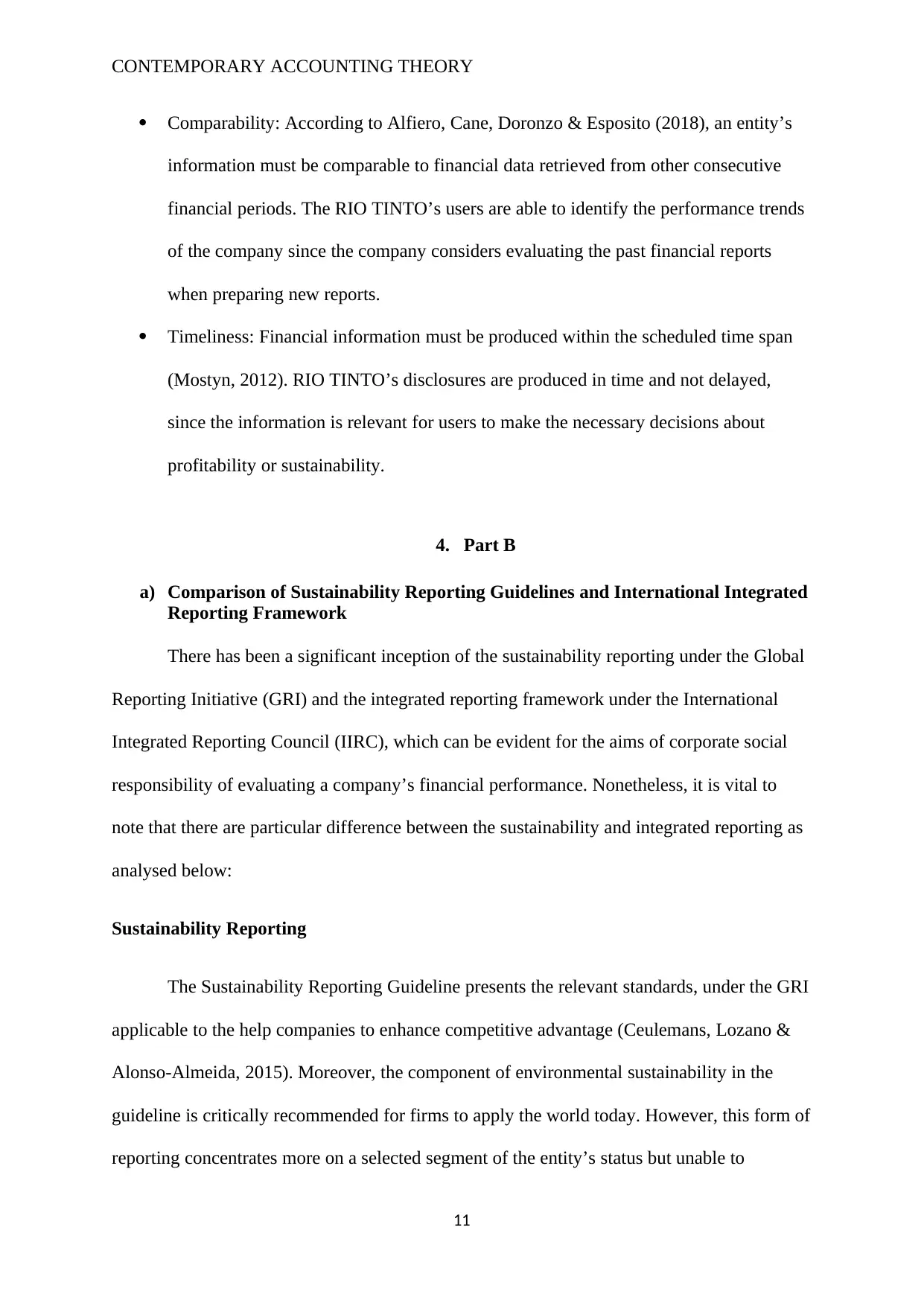
Comparability: According to Alfiero, Cane, Doronzo & Esposito (2018), an entity’s
information must be comparable to financial data retrieved from other consecutive
financial periods. The RIO TINTO’s users are able to identify the performance trends
of the company since the company considers evaluating the past financial reports
when preparing new reports.
Timeliness: Financial information must be produced within the scheduled time span
(Mostyn, 2012). RIO TINTO’s disclosures are produced in time and not delayed,
since the information is relevant for users to make the necessary decisions about
profitability or sustainability.
4. Part B
a) Comparison of Sustainability Reporting Guidelines and International Integrated
Reporting Framework
There has been a significant inception of the sustainability reporting under the Global
Reporting Initiative (GRI) and the integrated reporting framework under the International
Integrated Reporting Council (IIRC), which can be evident for the aims of corporate social
responsibility of evaluating a company’s financial performance. Nonetheless, it is vital to
note that there are particular difference between the sustainability and integrated reporting as
analysed below:
Sustainability Reporting
The Sustainability Reporting Guideline presents the relevant standards, under the GRI
applicable to the help companies to enhance competitive advantage (Ceulemans, Lozano &
Alonso-Almeida, 2015). Moreover, the component of environmental sustainability in the
guideline is critically recommended for firms to apply the world today. However, this form of
reporting concentrates more on a selected segment of the entity’s status but unable to
11
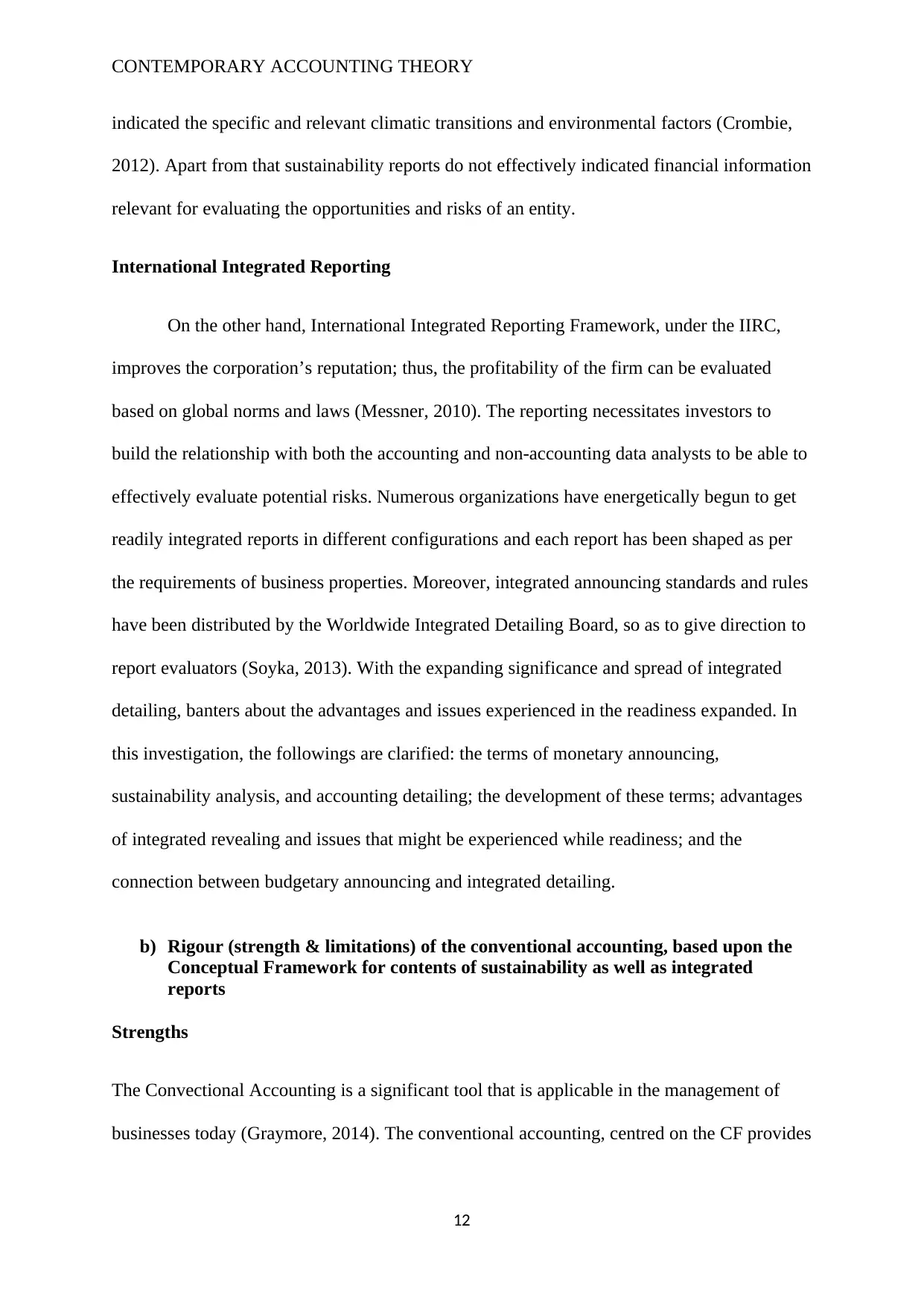
indicated the specific and relevant climatic transitions and environmental factors (Crombie,
2012). Apart from that sustainability reports do not effectively indicated financial information
relevant for evaluating the opportunities and risks of an entity.
International Integrated Reporting
On the other hand, International Integrated Reporting Framework, under the IIRC,
improves the corporation’s reputation; thus, the profitability of the firm can be evaluated
based on global norms and laws (Messner, 2010). The reporting necessitates investors to
build the relationship with both the accounting and non-accounting data analysts to be able to
effectively evaluate potential risks. Numerous organizations have energetically begun to get
readily integrated reports in different configurations and each report has been shaped as per
the requirements of business properties. Moreover, integrated announcing standards and rules
have been distributed by the Worldwide Integrated Detailing Board, so as to give direction to
report evaluators (Soyka, 2013). With the expanding significance and spread of integrated
detailing, banters about the advantages and issues experienced in the readiness expanded. In
this investigation, the followings are clarified: the terms of monetary announcing,
sustainability analysis, and accounting detailing; the development of these terms; advantages
of integrated revealing and issues that might be experienced while readiness; and the
connection between budgetary announcing and integrated detailing.
b) Rigour (strength & limitations) of the conventional accounting, based upon the
Conceptual Framework for contents of sustainability as well as integrated
reports
Strengths
The Convectional Accounting is a significant tool that is applicable in the management of
businesses today (Graymore, 2014). The conventional accounting, centred on the CF provides
12
⊘ This is a preview!⊘
Do you want full access?
Subscribe today to unlock all pages.

Trusted by 1+ million students worldwide
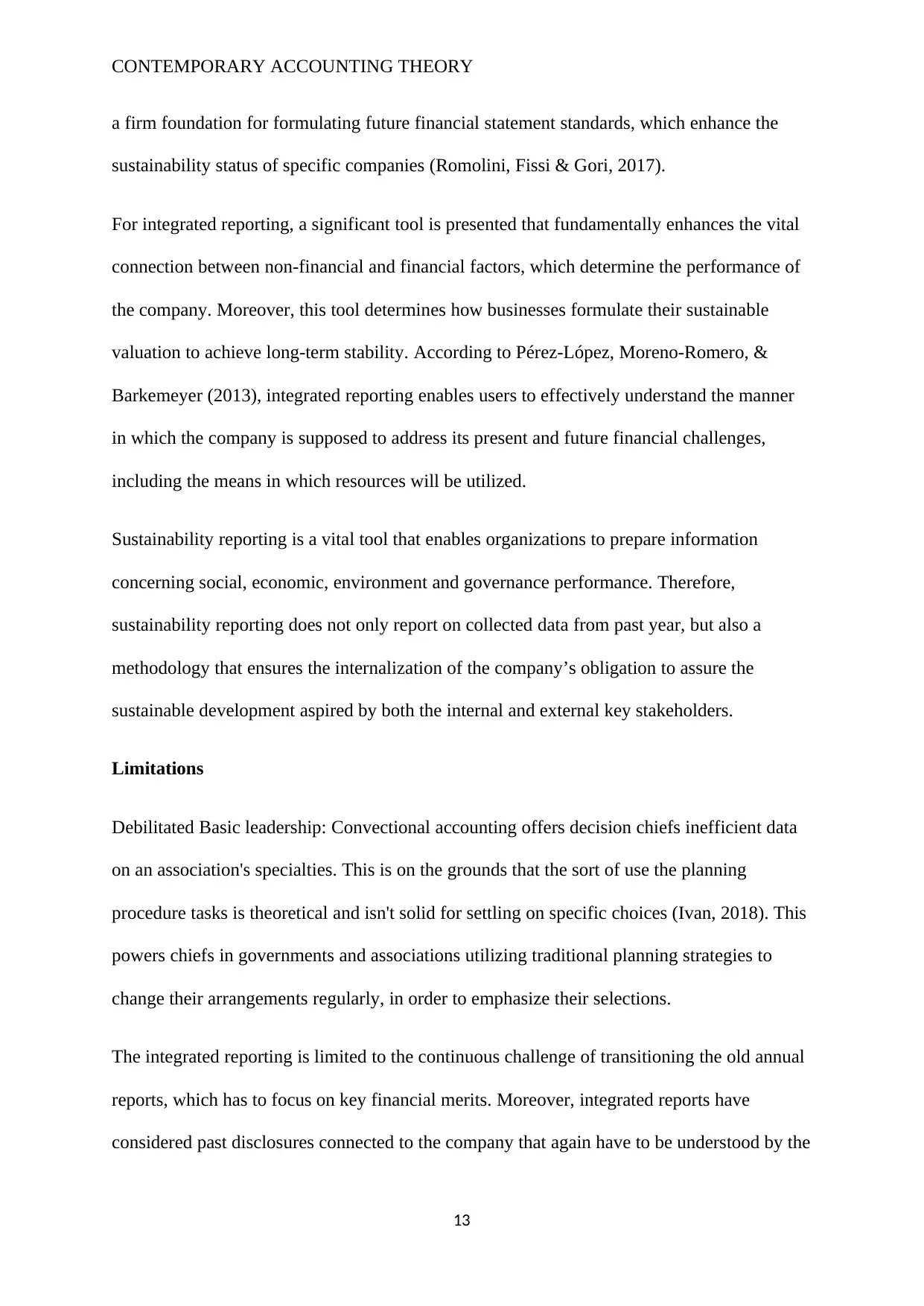
a firm foundation for formulating future financial statement standards, which enhance the
sustainability status of specific companies (Romolini, Fissi & Gori, 2017).
For integrated reporting, a significant tool is presented that fundamentally enhances the vital
connection between non-financial and financial factors, which determine the performance of
the company. Moreover, this tool determines how businesses formulate their sustainable
valuation to achieve long-term stability. According to Pérez-López, Moreno-Romero, &
Barkemeyer (2013), integrated reporting enables users to effectively understand the manner
in which the company is supposed to address its present and future financial challenges,
including the means in which resources will be utilized.
Sustainability reporting is a vital tool that enables organizations to prepare information
concerning social, economic, environment and governance performance. Therefore,
sustainability reporting does not only report on collected data from past year, but also a
methodology that ensures the internalization of the company’s obligation to assure the
sustainable development aspired by both the internal and external key stakeholders.
Limitations
Debilitated Basic leadership: Convectional accounting offers decision chiefs inefficient data
on an association's specialties. This is on the grounds that the sort of use the planning
procedure tasks is theoretical and isn't solid for settling on specific choices (Ivan, 2018). This
powers chiefs in governments and associations utilizing traditional planning strategies to
change their arrangements regularly, in order to emphasize their selections.
The integrated reporting is limited to the continuous challenge of transitioning the old annual
reports, which has to focus on key financial merits. Moreover, integrated reports have
considered past disclosures connected to the company that again have to be understood by the
13
Paraphrase This Document
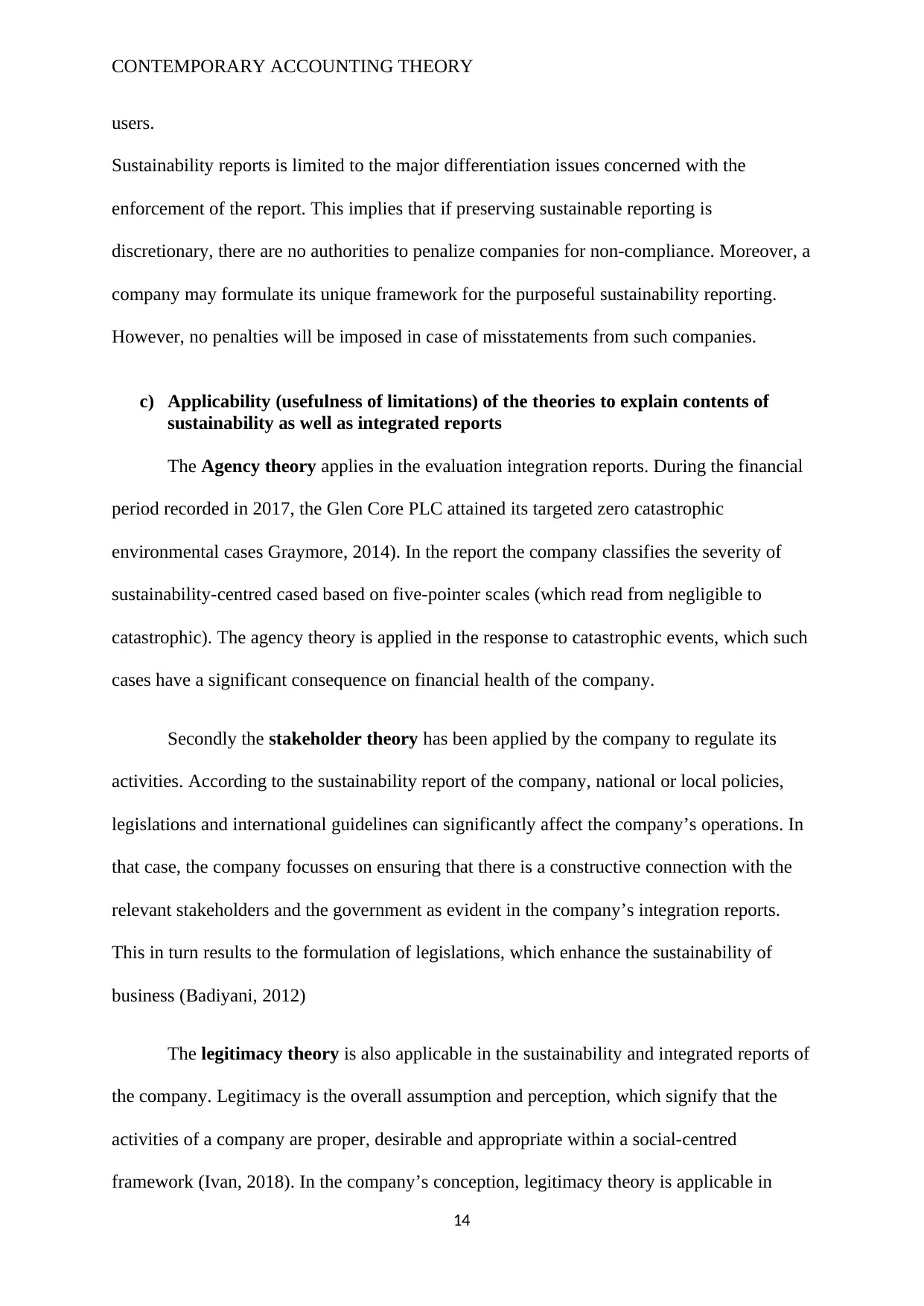
users.
Sustainability reports is limited to the major differentiation issues concerned with the
enforcement of the report. This implies that if preserving sustainable reporting is
discretionary, there are no authorities to penalize companies for non-compliance. Moreover, a
company may formulate its unique framework for the purposeful sustainability reporting.
However, no penalties will be imposed in case of misstatements from such companies.
c) Applicability (usefulness of limitations) of the theories to explain contents of
sustainability as well as integrated reports
The Agency theory applies in the evaluation integration reports. During the financial
period recorded in 2017, the Glen Core PLC attained its targeted zero catastrophic
environmental cases Graymore, 2014). In the report the company classifies the severity of
sustainability-centred cased based on five-pointer scales (which read from negligible to
catastrophic). The agency theory is applied in the response to catastrophic events, which such
cases have a significant consequence on financial health of the company.
Secondly the stakeholder theory has been applied by the company to regulate its
activities. According to the sustainability report of the company, national or local policies,
legislations and international guidelines can significantly affect the company’s operations. In
that case, the company focusses on ensuring that there is a constructive connection with the
relevant stakeholders and the government as evident in the company’s integration reports.
This in turn results to the formulation of legislations, which enhance the sustainability of
business (Badiyani, 2012)
The legitimacy theory is also applicable in the sustainability and integrated reports of
the company. Legitimacy is the overall assumption and perception, which signify that the
activities of a company are proper, desirable and appropriate within a social-centred
framework (Ivan, 2018). In the company’s conception, legitimacy theory is applicable in
14
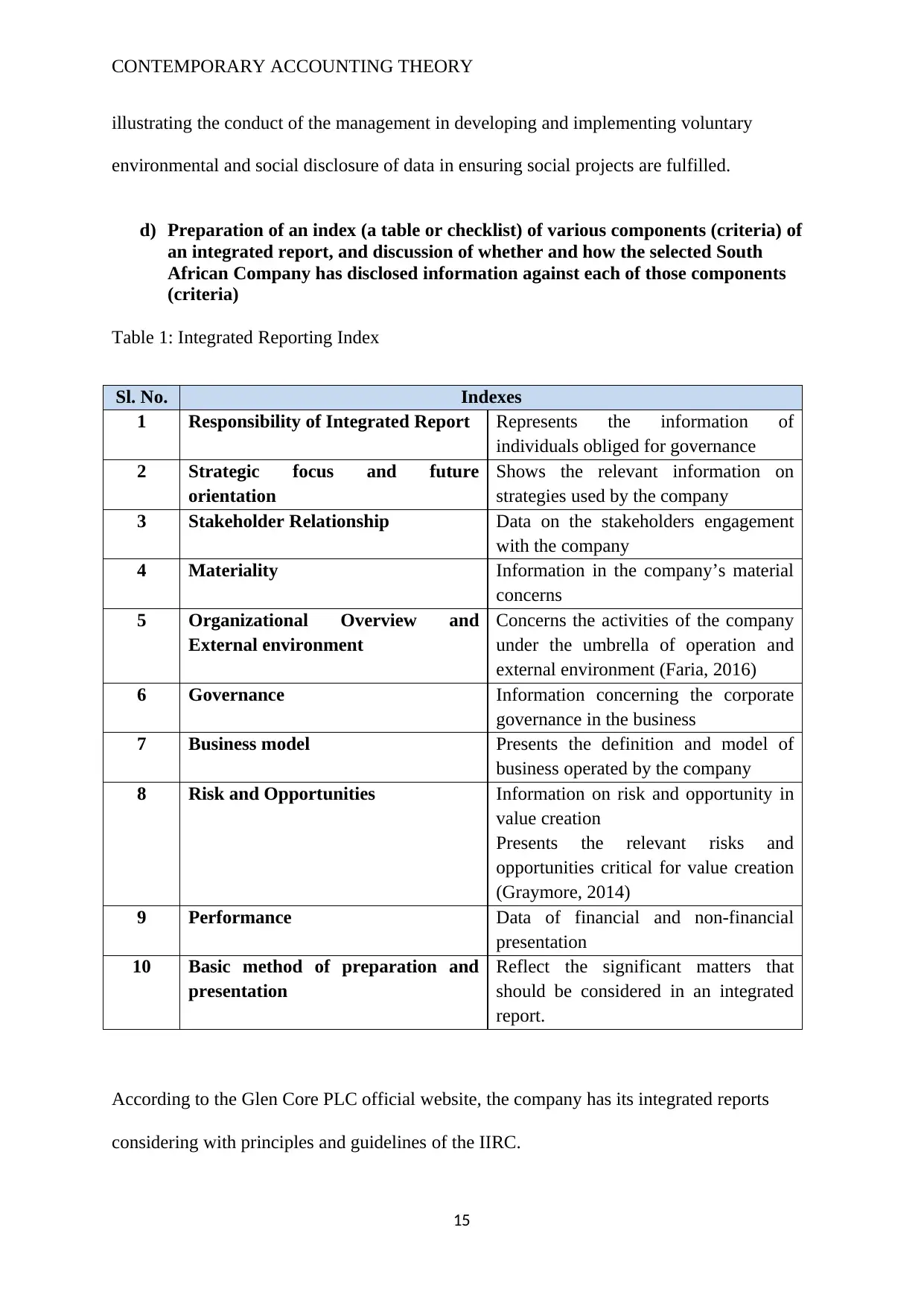
illustrating the conduct of the management in developing and implementing voluntary
environmental and social disclosure of data in ensuring social projects are fulfilled.
d) Preparation of an index (a table or checklist) of various components (criteria) of
an integrated report, and discussion of whether and how the selected South
African Company has disclosed information against each of those components
(criteria)
Table 1: Integrated Reporting Index
Sl. No. Indexes
1 Responsibility of Integrated Report Represents the information of
individuals obliged for governance
2 Strategic focus and future
orientation
Shows the relevant information on
strategies used by the company
3 Stakeholder Relationship Data on the stakeholders engagement
with the company
4 Materiality Information in the company’s material
concerns
5 Organizational Overview and
External environment
Concerns the activities of the company
under the umbrella of operation and
external environment (Faria, 2016)
6 Governance Information concerning the corporate
governance in the business
7 Business model Presents the definition and model of
business operated by the company
8 Risk and Opportunities Information on risk and opportunity in
value creation
Presents the relevant risks and
opportunities critical for value creation
(Graymore, 2014)
9 Performance Data of financial and non-financial
presentation
10 Basic method of preparation and
presentation
Reflect the significant matters that
should be considered in an integrated
report.
According to the Glen Core PLC official website, the company has its integrated reports
considering with principles and guidelines of the IIRC.
15
⊘ This is a preview!⊘
Do you want full access?
Subscribe today to unlock all pages.

Trusted by 1+ million students worldwide
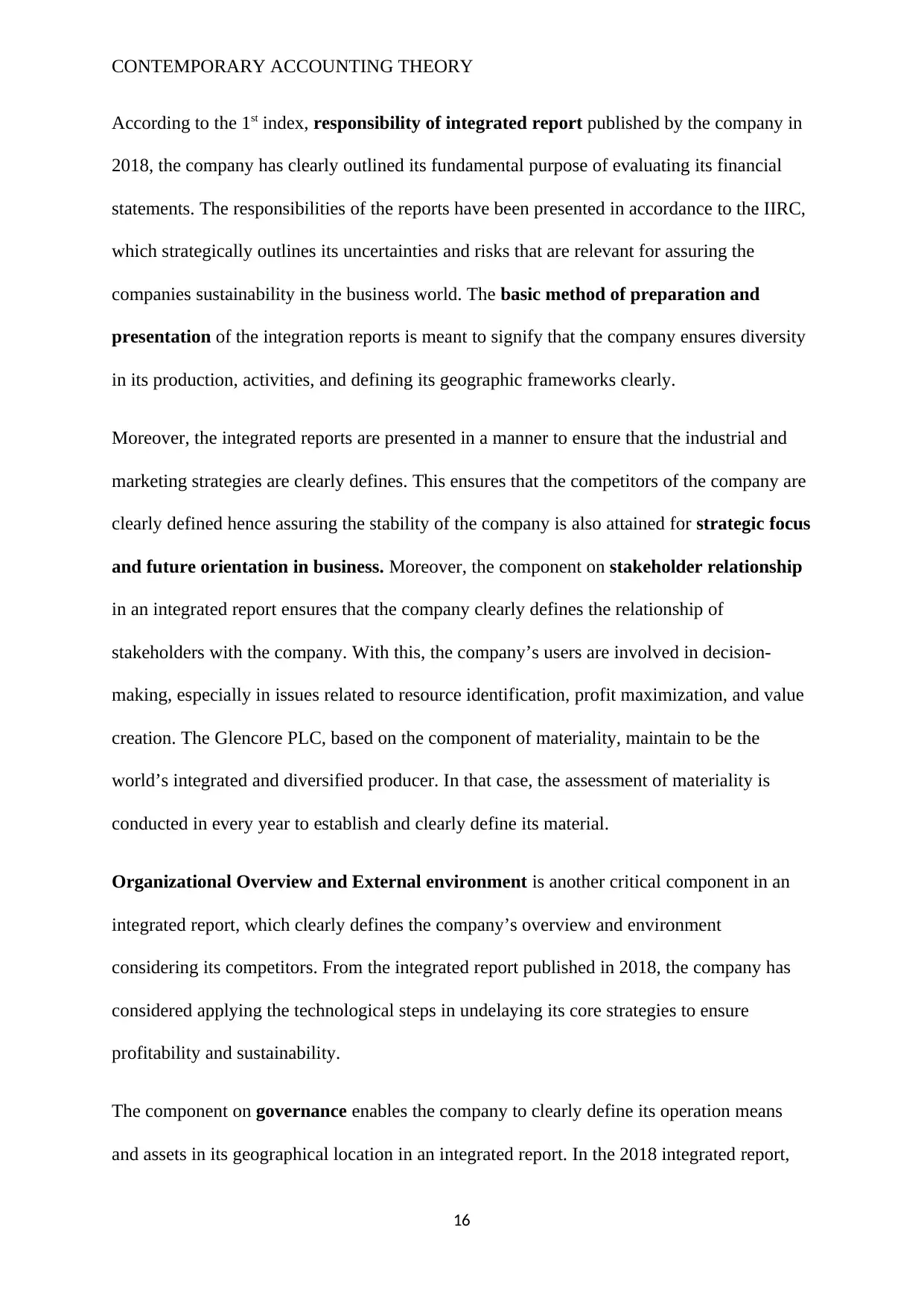
According to the 1st index, responsibility of integrated report published by the company in
2018, the company has clearly outlined its fundamental purpose of evaluating its financial
statements. The responsibilities of the reports have been presented in accordance to the IIRC,
which strategically outlines its uncertainties and risks that are relevant for assuring the
companies sustainability in the business world. The basic method of preparation and
presentation of the integration reports is meant to signify that the company ensures diversity
in its production, activities, and defining its geographic frameworks clearly.
Moreover, the integrated reports are presented in a manner to ensure that the industrial and
marketing strategies are clearly defines. This ensures that the competitors of the company are
clearly defined hence assuring the stability of the company is also attained for strategic focus
and future orientation in business. Moreover, the component on stakeholder relationship
in an integrated report ensures that the company clearly defines the relationship of
stakeholders with the company. With this, the company’s users are involved in decision-
making, especially in issues related to resource identification, profit maximization, and value
creation. The Glencore PLC, based on the component of materiality, maintain to be the
world’s integrated and diversified producer. In that case, the assessment of materiality is
conducted in every year to establish and clearly define its material.
Organizational Overview and External environment is another critical component in an
integrated report, which clearly defines the company’s overview and environment
considering its competitors. From the integrated report published in 2018, the company has
considered applying the technological steps in undelaying its core strategies to ensure
profitability and sustainability.
The component on governance enables the company to clearly define its operation means
and assets in its geographical location in an integrated report. In the 2018 integrated report,
16
Paraphrase This Document
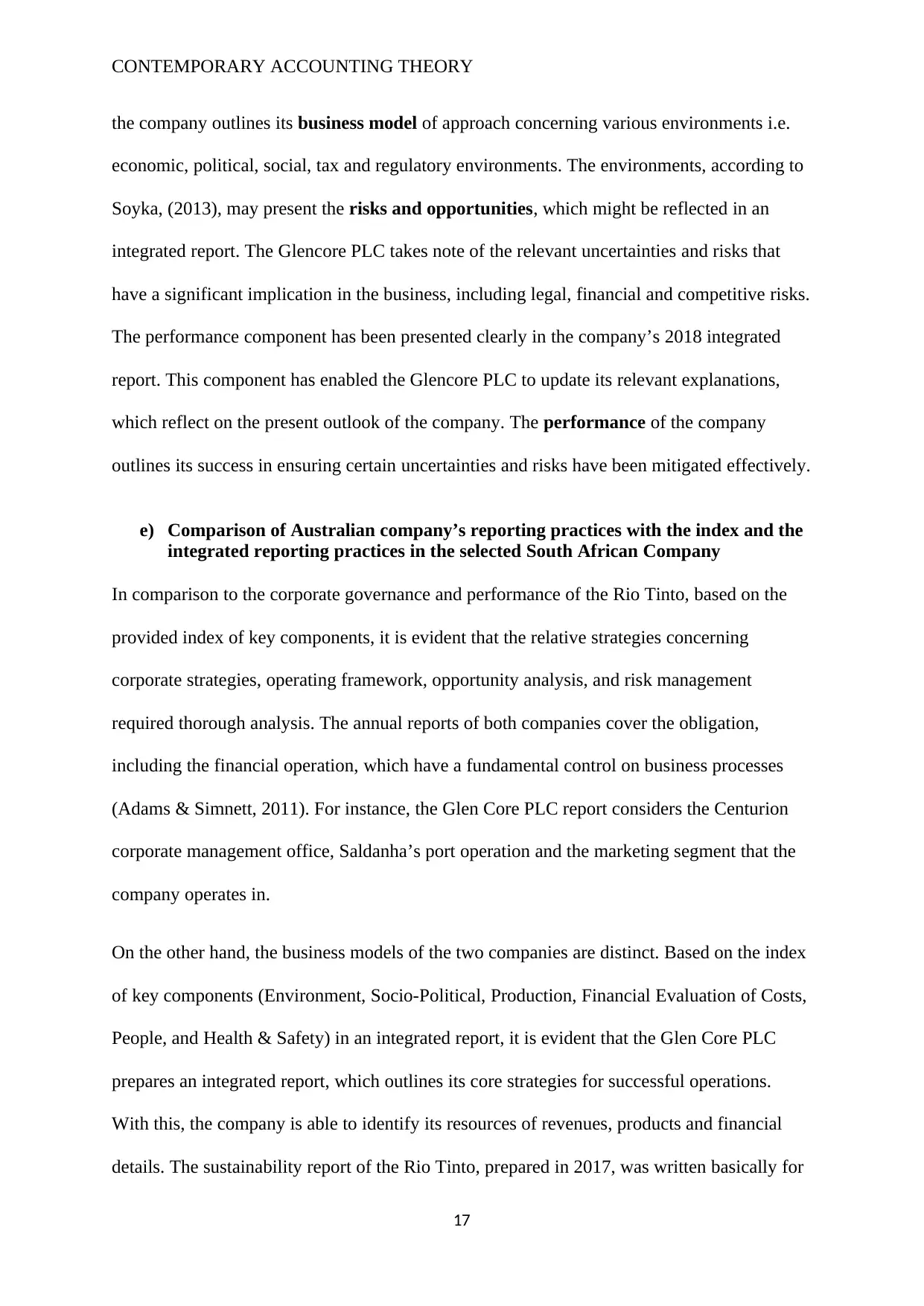
the company outlines its business model of approach concerning various environments i.e.
economic, political, social, tax and regulatory environments. The environments, according to
Soyka, (2013), may present the risks and opportunities, which might be reflected in an
integrated report. The Glencore PLC takes note of the relevant uncertainties and risks that
have a significant implication in the business, including legal, financial and competitive risks.
The performance component has been presented clearly in the company’s 2018 integrated
report. This component has enabled the Glencore PLC to update its relevant explanations,
which reflect on the present outlook of the company. The performance of the company
outlines its success in ensuring certain uncertainties and risks have been mitigated effectively.
e) Comparison of Australian company’s reporting practices with the index and the
integrated reporting practices in the selected South African Company
In comparison to the corporate governance and performance of the Rio Tinto, based on the
provided index of key components, it is evident that the relative strategies concerning
corporate strategies, operating framework, opportunity analysis, and risk management
required thorough analysis. The annual reports of both companies cover the obligation,
including the financial operation, which have a fundamental control on business processes
(Adams & Simnett, 2011). For instance, the Glen Core PLC report considers the Centurion
corporate management office, Saldanha’s port operation and the marketing segment that the
company operates in.
On the other hand, the business models of the two companies are distinct. Based on the index
of key components (Environment, Socio-Political, Production, Financial Evaluation of Costs,
People, and Health & Safety) in an integrated report, it is evident that the Glen Core PLC
prepares an integrated report, which outlines its core strategies for successful operations.
With this, the company is able to identify its resources of revenues, products and financial
details. The sustainability report of the Rio Tinto, prepared in 2017, was written basically for
17
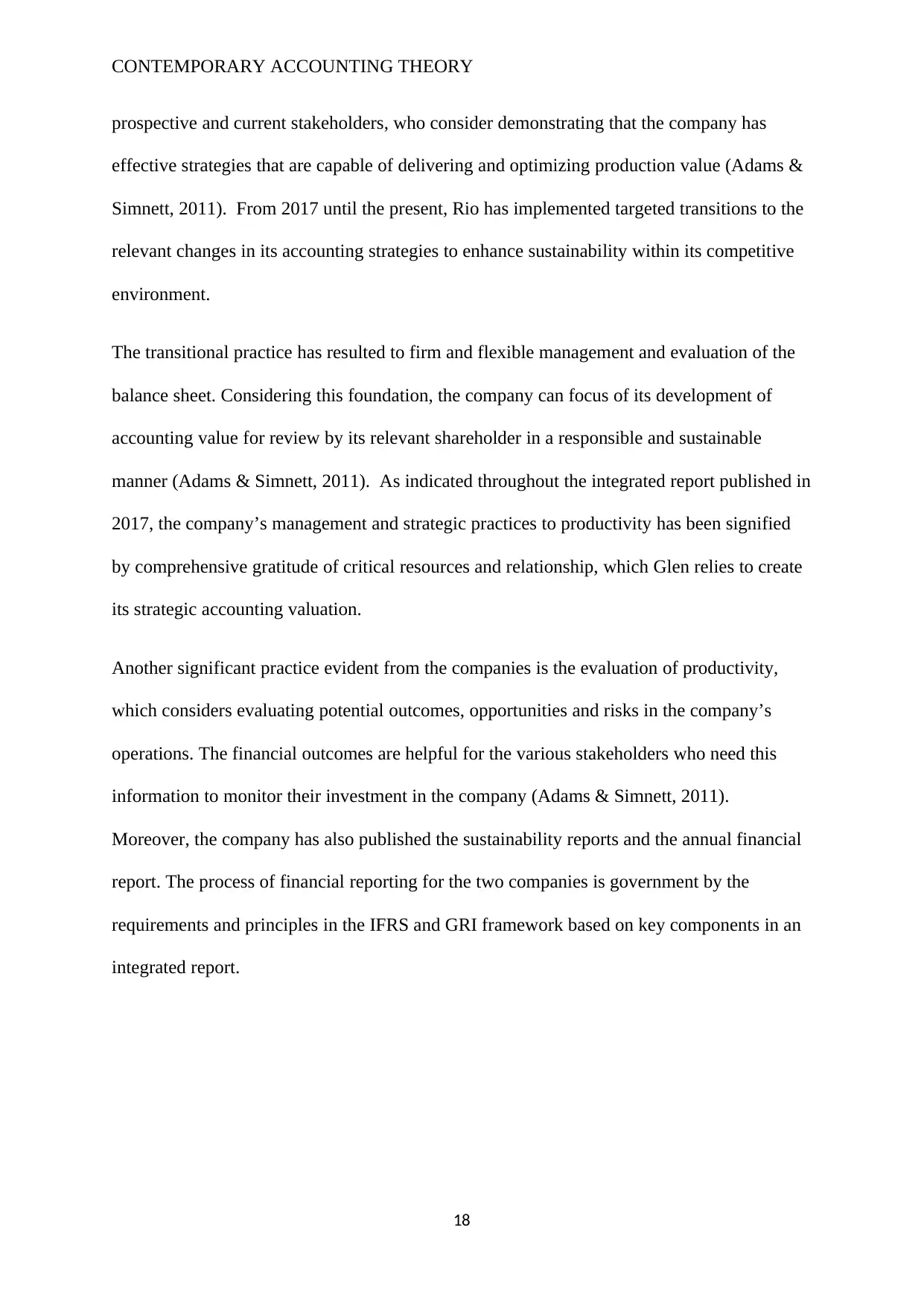
prospective and current stakeholders, who consider demonstrating that the company has
effective strategies that are capable of delivering and optimizing production value (Adams &
Simnett, 2011). From 2017 until the present, Rio has implemented targeted transitions to the
relevant changes in its accounting strategies to enhance sustainability within its competitive
environment.
The transitional practice has resulted to firm and flexible management and evaluation of the
balance sheet. Considering this foundation, the company can focus of its development of
accounting value for review by its relevant shareholder in a responsible and sustainable
manner (Adams & Simnett, 2011). As indicated throughout the integrated report published in
2017, the company’s management and strategic practices to productivity has been signified
by comprehensive gratitude of critical resources and relationship, which Glen relies to create
its strategic accounting valuation.
Another significant practice evident from the companies is the evaluation of productivity,
which considers evaluating potential outcomes, opportunities and risks in the company’s
operations. The financial outcomes are helpful for the various stakeholders who need this
information to monitor their investment in the company (Adams & Simnett, 2011).
Moreover, the company has also published the sustainability reports and the annual financial
report. The process of financial reporting for the two companies is government by the
requirements and principles in the IFRS and GRI framework based on key components in an
integrated report.
18
⊘ This is a preview!⊘
Do you want full access?
Subscribe today to unlock all pages.

Trusted by 1+ million students worldwide

5. Conclusion
The CF enables the firm’s managers to evaluate their financial health hence assuring
the company’s profitability. The conceptual framework signifies a critical concern in the
financial accounting field, which fundamentally deals with the monitoring and preparation of
audited financial statements. The founding concern of the CF and Integrated Reports is
crucial for key stakeholders and company users to retried data concerning the company’s
profitability. Resultantly, the structure presents the necessary data that can be used as a basis
for financial decision for companies since the information is relevant, applicable and error-
free. Thus, the financial frameworks have enabled the Glen Core PLC and Jupiter Mines to
enable its profitability in the world of accounting.
19
Paraphrase This Document
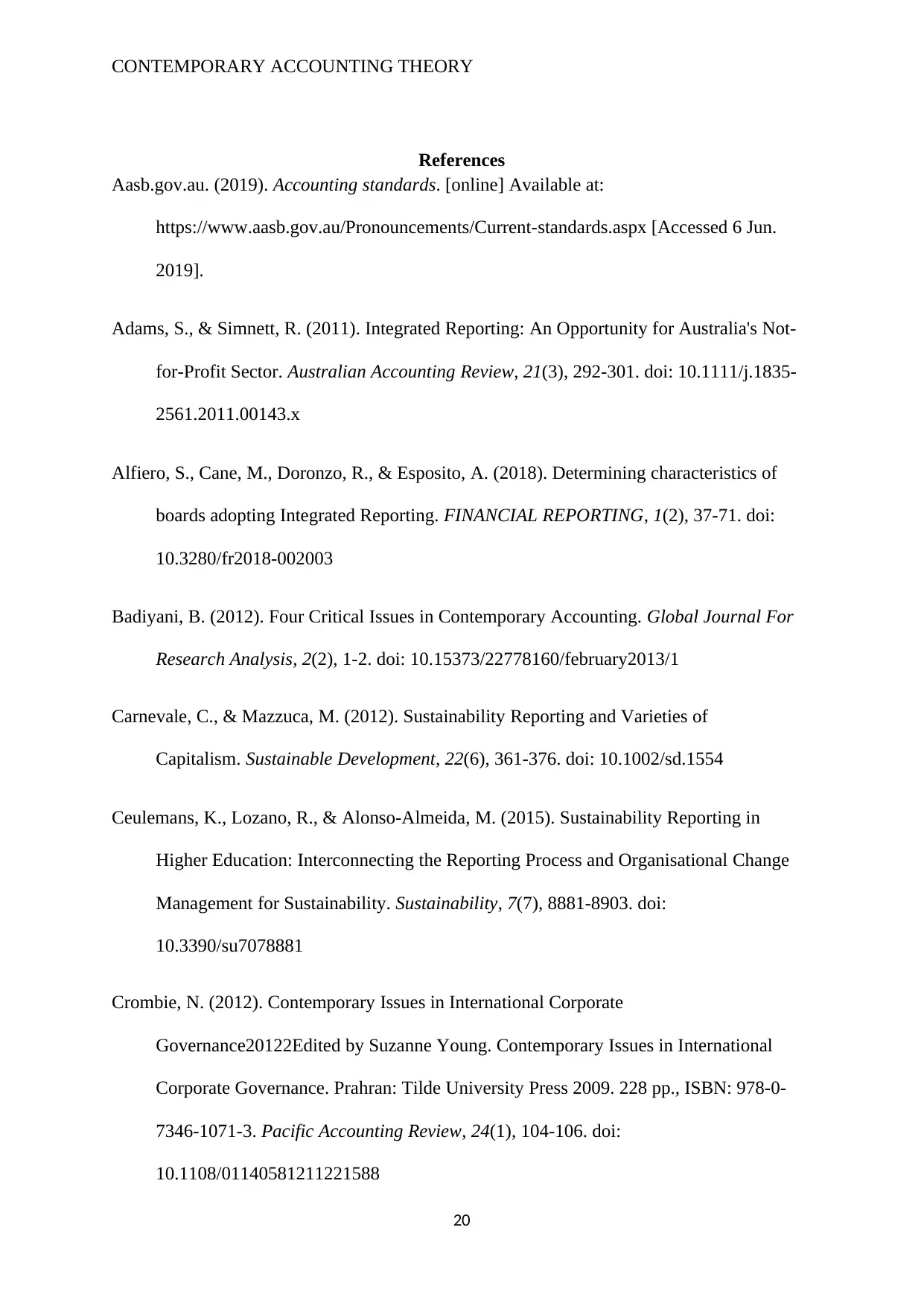
References
Aasb.gov.au. (2019). Accounting standards. [online] Available at:
https://www.aasb.gov.au/Pronouncements/Current-standards.aspx [Accessed 6 Jun.
2019].
Adams, S., & Simnett, R. (2011). Integrated Reporting: An Opportunity for Australia's Not-
for-Profit Sector. Australian Accounting Review, 21(3), 292-301. doi: 10.1111/j.1835-
2561.2011.00143.x
Alfiero, S., Cane, M., Doronzo, R., & Esposito, A. (2018). Determining characteristics of
boards adopting Integrated Reporting. FINANCIAL REPORTING, 1(2), 37-71. doi:
10.3280/fr2018-002003
Badiyani, B. (2012). Four Critical Issues in Contemporary Accounting. Global Journal For
Research Analysis, 2(2), 1-2. doi: 10.15373/22778160/february2013/1
Carnevale, C., & Mazzuca, M. (2012). Sustainability Reporting and Varieties of
Capitalism. Sustainable Development, 22(6), 361-376. doi: 10.1002/sd.1554
Ceulemans, K., Lozano, R., & Alonso-Almeida, M. (2015). Sustainability Reporting in
Higher Education: Interconnecting the Reporting Process and Organisational Change
Management for Sustainability. Sustainability, 7(7), 8881-8903. doi:
10.3390/su7078881
Crombie, N. (2012). Contemporary Issues in International Corporate
Governance20122Edited by Suzanne Young. Contemporary Issues in International
Corporate Governance. Prahran: Tilde University Press 2009. 228 pp., ISBN: 978‐0‐
7346‐1071‐3. Pacific Accounting Review, 24(1), 104-106. doi:
10.1108/01140581211221588
20
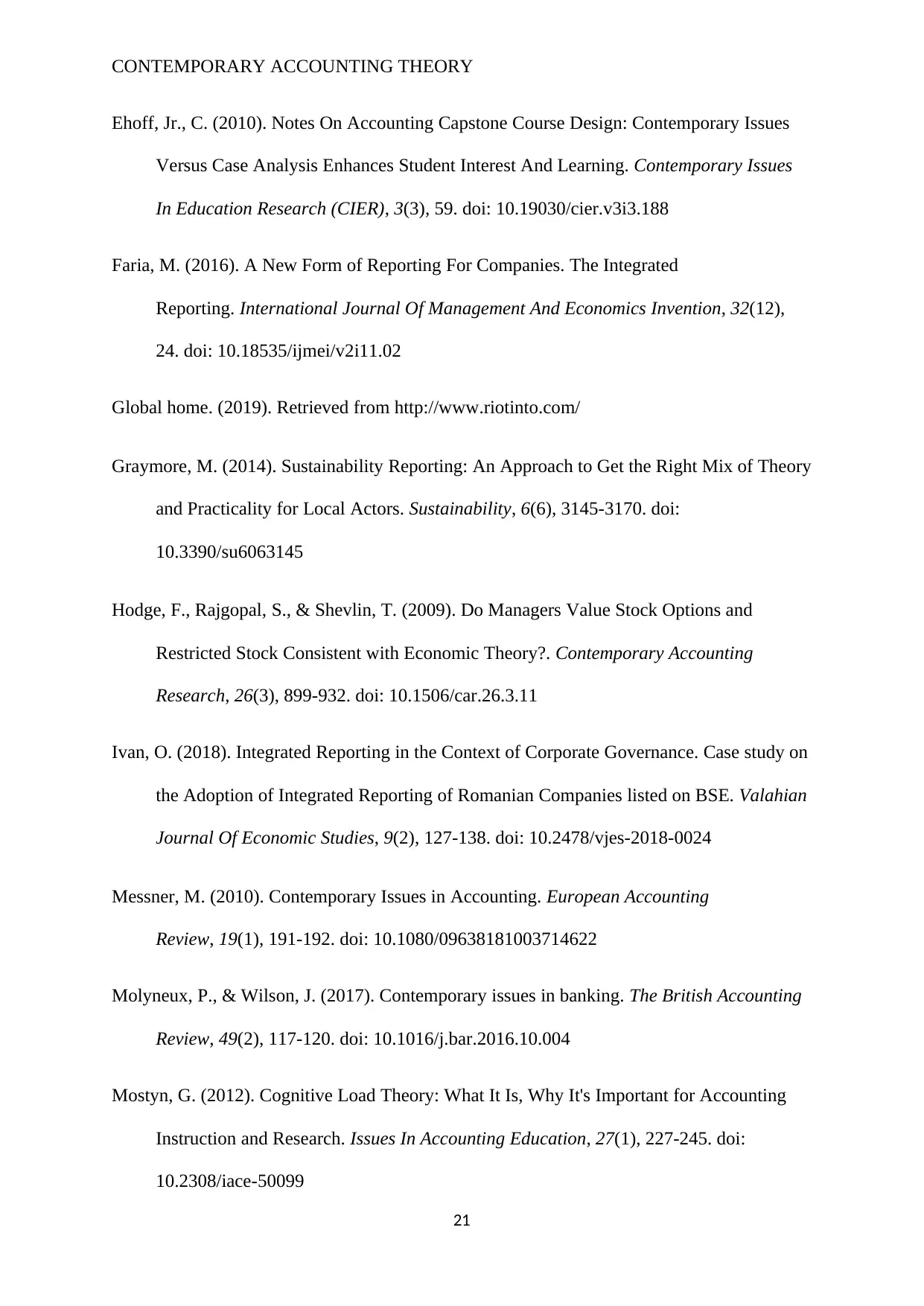
Ehoff, Jr., C. (2010). Notes On Accounting Capstone Course Design: Contemporary Issues
Versus Case Analysis Enhances Student Interest And Learning. Contemporary Issues
In Education Research (CIER), 3(3), 59. doi: 10.19030/cier.v3i3.188
Faria, M. (2016). A New Form of Reporting For Companies. The Integrated
Reporting. International Journal Of Management And Economics Invention, 32(12),
24. doi: 10.18535/ijmei/v2i11.02
Global home. (2019). Retrieved from http://www.riotinto.com/
Graymore, M. (2014). Sustainability Reporting: An Approach to Get the Right Mix of Theory
and Practicality for Local Actors. Sustainability, 6(6), 3145-3170. doi:
10.3390/su6063145
Hodge, F., Rajgopal, S., & Shevlin, T. (2009). Do Managers Value Stock Options and
Restricted Stock Consistent with Economic Theory?. Contemporary Accounting
Research, 26(3), 899-932. doi: 10.1506/car.26.3.11
Ivan, O. (2018). Integrated Reporting in the Context of Corporate Governance. Case study on
the Adoption of Integrated Reporting of Romanian Companies listed on BSE. Valahian
Journal Of Economic Studies, 9(2), 127-138. doi: 10.2478/vjes-2018-0024
Messner, M. (2010). Contemporary Issues in Accounting. European Accounting
Review, 19(1), 191-192. doi: 10.1080/09638181003714622
Molyneux, P., & Wilson, J. (2017). Contemporary issues in banking. The British Accounting
Review, 49(2), 117-120. doi: 10.1016/j.bar.2016.10.004
Mostyn, G. (2012). Cognitive Load Theory: What It Is, Why It's Important for Accounting
Instruction and Research. Issues In Accounting Education, 27(1), 227-245. doi:
10.2308/iace-50099
21
⊘ This is a preview!⊘
Do you want full access?
Subscribe today to unlock all pages.

Trusted by 1+ million students worldwide
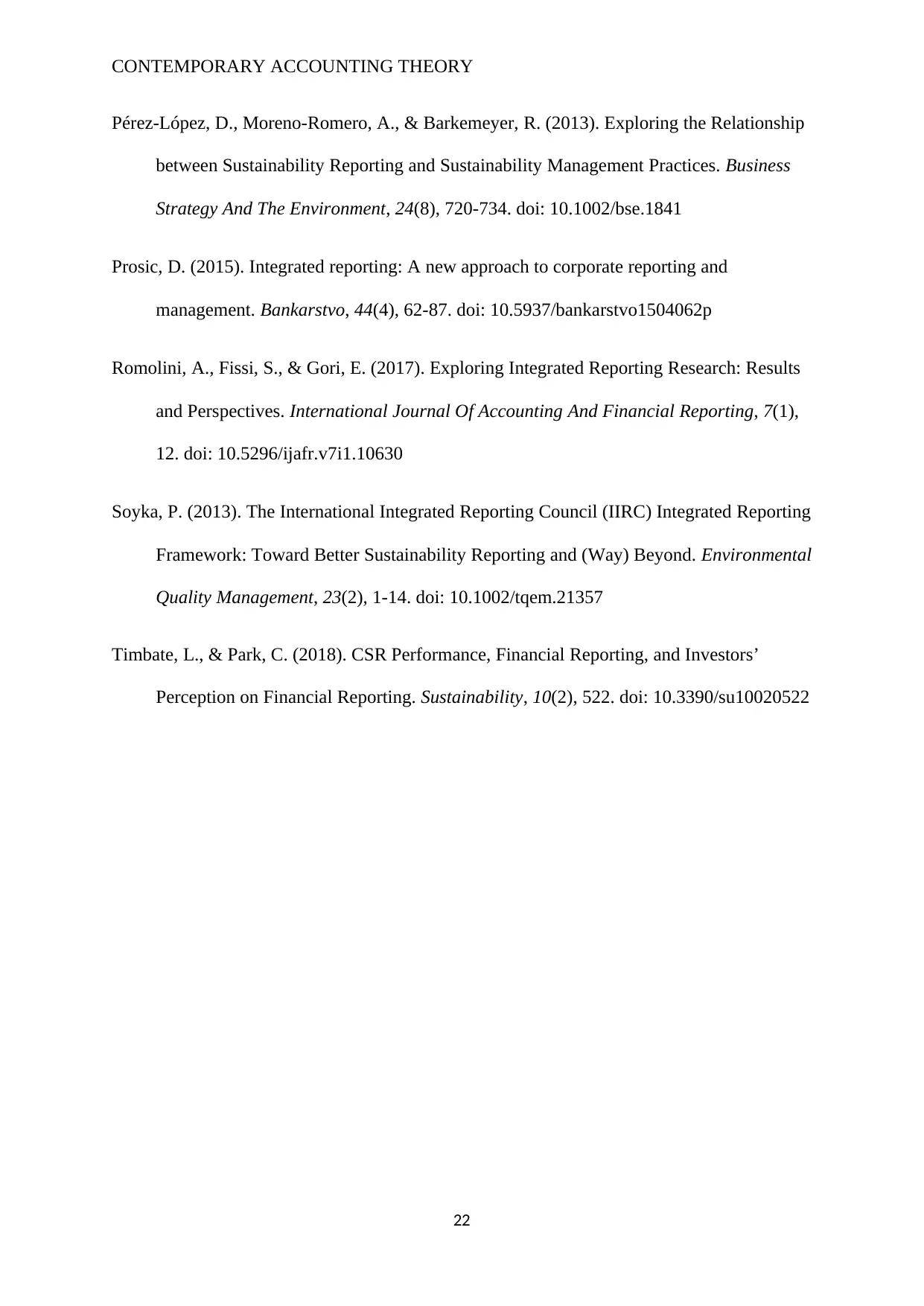
Pérez-López, D., Moreno-Romero, A., & Barkemeyer, R. (2013). Exploring the Relationship
between Sustainability Reporting and Sustainability Management Practices. Business
Strategy And The Environment, 24(8), 720-734. doi: 10.1002/bse.1841
Prosic, D. (2015). Integrated reporting: A new approach to corporate reporting and
management. Bankarstvo, 44(4), 62-87. doi: 10.5937/bankarstvo1504062p
Romolini, A., Fissi, S., & Gori, E. (2017). Exploring Integrated Reporting Research: Results
and Perspectives. International Journal Of Accounting And Financial Reporting, 7(1),
12. doi: 10.5296/ijafr.v7i1.10630
Soyka, P. (2013). The International Integrated Reporting Council (IIRC) Integrated Reporting
Framework: Toward Better Sustainability Reporting and (Way) Beyond. Environmental
Quality Management, 23(2), 1-14. doi: 10.1002/tqem.21357
Timbate, L., & Park, C. (2018). CSR Performance, Financial Reporting, and Investors’
Perception on Financial Reporting. Sustainability, 10(2), 522. doi: 10.3390/su10020522
22
Paraphrase This Document
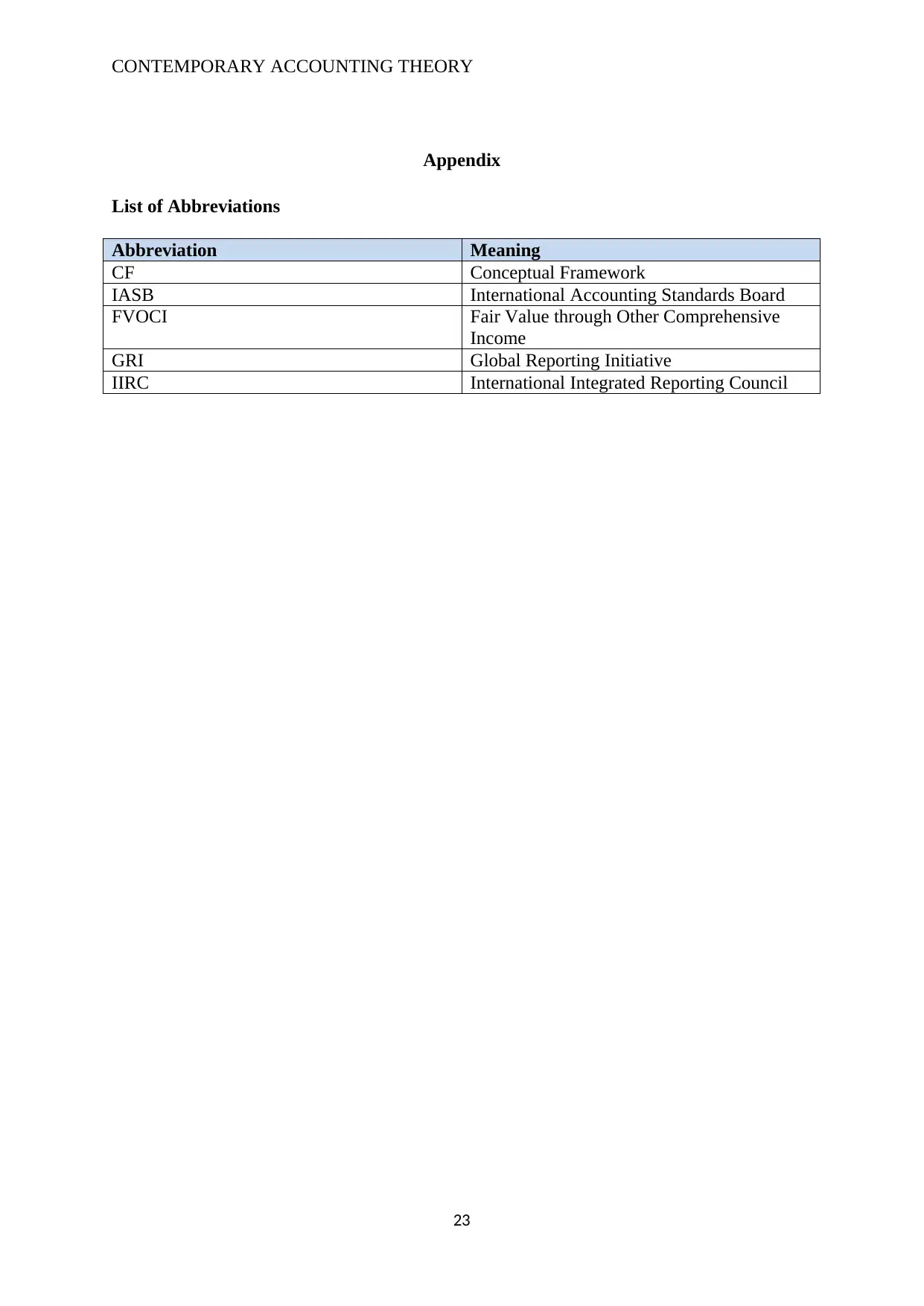
Appendix
List of Abbreviations
Abbreviation Meaning
CF Conceptual Framework
IASB International Accounting Standards Board
FVOCI Fair Value through Other Comprehensive
Income
GRI Global Reporting Initiative
IIRC International Integrated Reporting Council
23
Related Documents
Your All-in-One AI-Powered Toolkit for Academic Success.
+13062052269
info@desklib.com
Available 24*7 on WhatsApp / Email
![[object Object]](/_next/static/media/star-bottom.7253800d.svg)
© 2024 | Zucol Services PVT LTD | All rights reserved.





